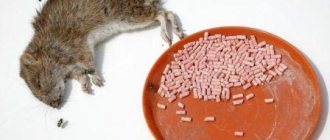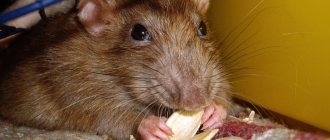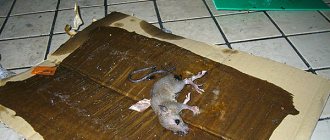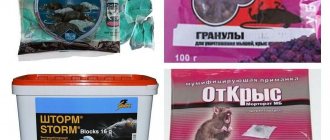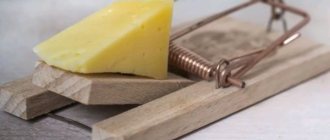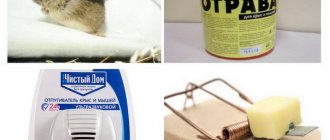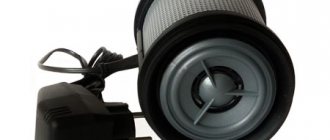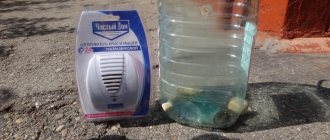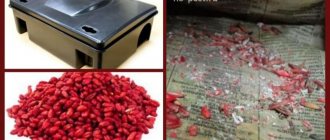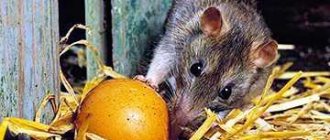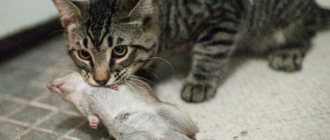An interesting phenomenon arose in the market for anti-rat drugs: sellers here were able to create demand for a product that they themselves had come up with. And this remedy is the so-called mummifying poison for rats.
It would seem, what is missing for buyers of rat poisons? There are quite effective poisons, and well-developed methods for reliably protecting pets from them, and the prices for such products are so low that everyone can use them.
However, there is an unresolved problem: rats decompose after death. And it is not at all uncommon for cases when, after the successful use of poison somewhere in an inaccessible place in an apartment, house or office, the corpse of a pest begins to mercilessly stink, making the room simply uninhabitable.
The photo below shows an example of a partially decomposed rat corpse:
Enterprising sellers quickly realized: if you promise the buyer that after a rat is poisoned, its corpse will not spoil the air in the room (due to decomposition), then such a drug will be much more in demand and will be easier to sell.
In general, this is how a rat repellent with a mummifying effect appeared on the market. According to sellers, it first poisons the pest, and then leads to a kind of preservation of the tissues of its body. As a result, the rat corpse does not decompose and does not stink, but simply dries out. Once they announced these properties of the poison, sellers discovered an active demand for it, and then quickly introduced such products into their permanent assortment.
On a note
It is not correct to say “mummified poison from rats and mice.” According to the rules of the Russian language, “mummified” is one who has himself turned into a mummy. For example, a rat or mouse can be mummified after it has died, but its body has dried out and not decomposed. The agent that provides this effect is mummifying. This means that the poison is mummifying, and not “mummified.”
Buyers understand the beauty of this effect and today are actively looking for mummifying rat poisons on sale - in the form of tablets, briquettes, poisoned grain, or drugs in other forms. At the same time, consumers do not even suspect that in fact, with statements about the “mummifying effect,” generally speaking, they are being led by the nose...
Everything you need to know about mummifying poisons
In fact, rat poisons with a mummifying effect, in the true sense of the phrase, do not exist on the market. The effect attributed to rodent poisons is simply an advertising ploy, a way to increase the attractiveness of the product, an empty promise and a feature made up by the seller.
The fact is that an inexpensive and competitive poison for rats, in principle, cannot be mummifying. To mummify the body of any animal, at least one of the following conditions must be met:
- Saturation of all animal tissues with substances that destroy decomposer bacteria;
- Or the corpse gets into conditions in which bacteria decomposing organic matter cannot exist.
An example of the first option is embalming the body, the results of which can be seen in the sarcophagi of the Egyptian pyramids or in the Mausoleum on Red Square in Moscow. An example of the second option is mummies of wild animals trapped in ice (it’s too cold for bacteria here), in the mud of swamps where there is no oxygen, or in very dry desert conditions where there is not enough moisture for the activity of decomposing microorganisms.
The second condition is unattainable in an apartment or office - microclimate parameters are always maintained here, quite normal for the decomposition of a rat corpse.
It is almost impossible to embalm a rat's body using poisoned bait, since such a procedure involves abundant saturation of the tissues with antibacterial agents. That is, you literally need to take a rat and soak it in a preservative.
On a note
Theoretically, mummification of a corpse can be achieved by adding special persistent broad-spectrum antibiotics to the poison, which do not decompose in the body for a long time. In this case, the rat will be killed by the poison, and the decomposer bacteria will be killed by the antibiotic. As a result, the corpse will not decompose (or the rate of decomposition will be very low) and will dry out faster than it stinks.
However, today there is no known poison for rats that contains such antibiotics. At a minimum, because such antibiotics are quite expensive - as a result, the poison would be very expensive and would not withstand competition in the market.
And now, perhaps, the most important thing: not a single official description and not a single instruction for rat repellents indicates their mummifying effect. This fact can be explained simply: drug manufacturers know very well that their products do not contain mummifying components and do not have the corresponding properties. They don't make anything up and are absolutely honest with customers. And non-existent properties are attributed to drugs by sellers who have little understanding of the theory, but skillfully use not entirely honest methods of increasing sales.
Review:
“I’m interested in this question: I look at the packaging of Storm, and there’s not a single word about mummification on it. And in the store the seller was straight up praising how good this mummified product was. I went to read on the Internet, half of the stores write that the product is mummified, half do not write this. There is a feeling that someone is coming up with something here..."
Tatiana, Tula
We conclude: no rat poison provides mummification of the corpses of dead rodents. However, there are quite a lot of products on sale that are positioned as mummifying. What effect then can be obtained from their use?
It is also useful to read: Rules for choosing the best ultrasonic mouse and rat repeller
Release form
Poison Rat death
The effectiveness of the poison largely depends on the form of release. Rat Death is produced in the form of a gel-like substance. It is given the appearance of a briquette and packed in filtered paper. Placed in a polymer film. Poison in bags is stored for 3 years from the date of manufacture.
An effective rat repellent can be purchased at any specialty store at an affordable price. The package contains 8 briquettes weighing 100 g, or 16 pieces with a total weight of 200 g. The active composition of the rat repellent and the successful release form have made the poison in demand on the market for similar products.
What products are sold as mummifying agents, and what is their real effect?
For example, the following are sold as mummifying poisons:
- Storm is perhaps the most popular remedy of this type. Contains flocumafen - in fact, a poison that, when released into the blood, blocks its clotting mechanism and causes the death of the animal due to multiple internal hemorrhages. The mummification effect for this substance is not known. Other components of the product are grain, dye and wax. So we can only wonder which ingredient out of all this is capable of turning a rat into a mummy. Storm's analogue is Goliath, the instructions for which say nothing about the mummifying effect;
- Mortorate, its active ingredient is brodifacoum. It acts similarly to Storm; in the official instructions from the manufacturer there is no mention of the mummifying effect;
- Nutcracker and Rat Death are analogues of Mortorate with the same active ingredient;
- Best is a drug based on bromadiolone. Its mummifying properties are also not known.
As we can see, there is no reason to believe that the corpse of a rat or mouse poisoned with one of these drugs will suddenly be mummified and become “inedible” for bacteria.
And yet, not only sellers, but also many buyers in reviews talk about the mummifying effect. But is this enough to believe in such an effect?
Features of using products on various surfaces
We will not treat all materials that exude a mouse-like “amber” in the same way. Some require a special approach.
Chipboard
For this material we will follow the algorithm:
- Stain analysis. Rodent urine, due to its ammonia content, can stain the surface of the chipboard. The latter may become discolored or even change its density. It follows from this that it has become thinner, which is why it needs to be diluted with a solution of a weaker consistency. It is also necessary to reduce the exposure time to the chemical.
- The surface for treatment must be prepared: remove all dust and dirt with your own hands or with a special device, and finally degrease.
- The next step is to process the chipboard. It is better to do this from both sides - excrement could be absorbed into the body of the material. If you use a chemical aerosol, then after treatment you need to wait until it is completely absorbed, and then remove the sediment with a rag.
- Once the chipboard is completely dry, it is recommended to treat it with sealants or polish.
Drywall
Unfortunately, if excrement or putrefactive liquid has seeped through the drywall, then this part will be the easiest to remove. By no means can you completely remove the smell from it.
To investigate this fact, you need to remove the drywall and check for stains on the back side. If they are not there, you can treat the surface using one of the methods we propose.
Will ultrasound help?
Natural wood
In the case of wood, you need to remember one thing - in no case overdo it with the amount of solution. If there is too much of it, then the material will swell from excess moisture and particles emitting an unpleasant odor will sink even deeper into its pores, from where it will be even more problematic to remove them.
The best option for wood is to first treat the surface with an absorbent, and then with vinegar, peroxide, etc. or a chemical aerosol. Finally, restore the surface using polish or sealant.
Why do they say that mummifying poisons actually “mummify”?
In reality, the likelihood that a rat will die in an apartment or inside a private home is low. As a rule, animals make their nests outside residential premises: in basements or attics, in areas near houses, on dryers in apartment buildings, in hallways and garbage bins. Even from a powerful poison, they do not die immediately, but only after a few hours or even days, but when their condition worsens, they hide in their shelters. Here, near the nest, the cadaverous smell from the dead animal spreads.
Consequently, if a rat dies from poison not in the house, where it runs only in search of food, but outside it, then its corpse will not stink in the room itself. But a person who bought bait with a supposed “mummifying” effect will be sure that there is no smell precisely because the rats somewhere under the floor or behind the wall have turned into mummies. Although in fact they had already safely decomposed somewhere outside the apartment, they “stank” and all that was left of them were bones and wool.
And yet it happens that poisoned rats die inside apartments, offices, private houses and begin to stink mercilessly. Moreover, such situations often develop precisely after the use of “mummifying” poisons...
Review
“These mummifying rat baits don’t work! A rat died somewhere under the floor and it stinks so bad you can’t go into the house. At least don’t dismantle the whole floor now!”
Svetlana, St. Petersburg
It is also useful to read: The best types of rat traps for rodent control
Removing a Dead Rat
Removing a Dead Rat
The most important question in such a situation is how to find a dead rat and remove its remains. Driven to despair, some owners are even capable of tearing off floors or opening walls in search of sources of the terrible stench and getting rid of harmful miasmas.
Effective ways to solve this problem:
- The best thing to do would be to find a decomposing corpse, put it in a trash bag and throw it away. During this procedure, it is necessary to wear protective gloves and a respirator. If the dead rat is in a hard-to-reach place, it is recommended to use a stick with a hook to pick it up and get it out, or a strong wire.
- If a decomposed rat corpse lies on the ground, then it should be borne in mind that the soil well absorbs the fetid secretions from it and the smell itself, so the soil in this area will have to be dug up with a shovel and thrown into the trash.
- The area under the floor where the dead rat lay should be sprinkled with soda, treated with a solution of potassium permanganate, and it is better to put lavender to neutralize the smell.
- It is necessary to arrange long-term ventilation in the room, always with a draft, and clean or wash all fabric products (curtains, curtains, carpets and runners, bedspreads and pillows on sofas).
- The furniture should be sprayed with a solution consisting of a quarter glass of soda, 1 tsp. soap and 1 liter of hydrogen peroxide. Spraying should be done from a spray bottle; after treatment, all surfaces should be wiped with a damp cloth. Chlorine-containing liquids can also be used for processing.
How effective are poisons with this effect?
However, the products that are sold under the guise of “mummifying” are for the most part quite effective rat poisons, specifically designed to kill rodents and cope well with this task. Rats and mice die after eating them, and for the reasons stated above, the use of these products does not usually result in a decomposing odor in the premises. Although such preparations do not guarantee the absence of odor in the room, they are quite capable of killing a rat.
Therefore, Storm, Nutcracker, and all other products based on blood anticoagulants can be safely used in accordance with the instructions. They are laid out in those places in the room where rats and mice are most often, and new portions are added as the old ones are eaten by pests. Typically, rats die 3-4 days after they feed on such bait for the first time (sometimes, depending on the amount of poison eaten, the effect occurs earlier or later).
It is important to remember that most rat poisons are very toxic to pets and humans. Cats are especially sensitive to them. Therefore, baits are placed where pets cannot find them, ideally in special containers that only rats or mice can get into.
Review
“We are very pleased with the mummifying poisons. They have bred rats twice with them and they work great. They got rid of them once in the barn, once in the basement of the house. And indeed, there is no smell, the rats do not decompose. It’s better than if they lay somewhere and stink.”
Dmitry Pavlovich, Krasnodar
Rules for the use of poisons
When carrying out pest control, you should follow basic safety rules.:
- When laying out mouse poison, which is dangerous for humans, you should wear gloves, and, if possible, a respirator or protective suit.
- When working with volatile materials that may become airborne, keep all pets and small children away from the handling area.
- Mouse baits should not be scattered directly on the floor; it is better to place them on plastic backings.
- The poison is laid out in places where rodents are expected to live (near burrows, on travel routes, in places of shelter, along walls). The amount of bait depends on the area of the room.
- Mice carcasses should be removed immediately to prevent the spread of a putrid odor and also to protect pets who may gut the poisoned pests.
Modern mouse poison is highly effective, easy to use, and affordable. If proper safety measures are observed, deratization will not take much time and effort.
What else can you do to get rid of rats and mice so that there is no smell in the house?
So you can get rid of rats and mice in the house, so as not to suffer from cadaveric gases, in other ways. The best of them are mousetraps or rat traps, both crushers and those that catch animals alive.
After charging and installation, such a device should be checked regularly, and caught or killed animals should be removed from the apartment as far as possible. In this case, they definitely won’t stink up the room.
Also, many cats and some burrowing dogs - fox terriers and Jagd terriers - successfully catch rats and mice. They certainly won’t let their prey go to waste, although after a successful hunt and meal, pets may leave unaesthetic rodent paws or tails in the apartment.
You can’t just use poison at the same time and count on such helpers in the fight against rodents: even if a cat or dog doesn’t find poison, it can catch and eat a poisoned, but not yet dead rat, and poison itself. Therefore, for safety, you should first let a pet rat catcher into the room for 2-3 days, and if he can’t cope, then remove him and set traps or spread poison.
If you have personal experience with the use of “mummifying” poisons when fighting rats or mice, be sure to leave your review at the bottom of this page (in the comments field).
Useful video about using rat poisons
Types of mice
- House mouse - has a body size of 10-15 cm, males are larger than females, the average weight of the animal is from 15 to 50 grams. The color is uniform light gray or dark brown, the belly is always lighter, there are no distinctive spots or stripes. It is active around the clock, swims and climbs well.
- The field mouse is a small rodent with a body size of no more than 13 cm and an approximate weight of about 35 grams. The color of the skin is reddish-brown, a dark stripe appears on the back along the spine, and the belly of the animal is gray. It digs minks at a depth of 15-35 cm, its abode is a garden plot, it does not enter the house, it destroys the beds. The peak of activity occurs at night.
- Wood mouse - no more than 10 cm in size, dirty gray in color, without a clear stripe on the back with a white belly, there is a yellowish, red-brown spot on the chest. It uses the burrows of voles and moles, harms fruit crops, and eats seeds and green shoots.
- The yellow-necked mouse, reddish-gray in color with a light-colored abdomen, reaches a length of 13 cm and weighs up to 50 grams. Lives in burrows and tree hollows. Damages nurseries and gardens.
- The chiropteran mouse has a dense build with a short neck that turns into a thick head, a large mouth and modified forelimbs with leathery membranes that allow flight. In winter they usually hibernate and are active only at night.
